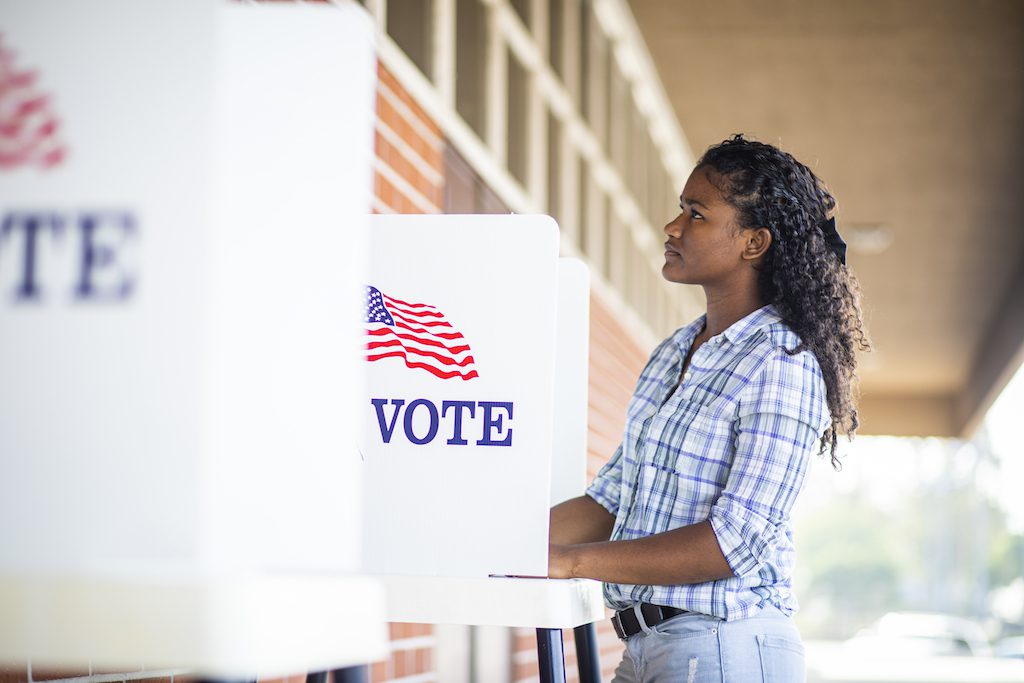 (Photo: adamkaz/Getty Images)
(Photo: adamkaz/Getty Images)
A sea of “I Voted” stickers surrounded me at my junior high school in 2016 the morning before Americans went to the polls. Students waiting to cast their ballots in our first-ever mock election debated the taglines of Trump’s immigration policy and the ethics of Clinton’s healthcare platform. The voting experience was complete with long lines, paper ballots, privacy screens, and, of course, the token sticker at the end. Students spent time doing research on candidates for the presidential and our local Utah gubernatorial race in history classes and cast their votes in our school common area.
These mock elections weren’t part of our school curriculum. However, 75% of students at my junior high school turned out to vote in that 2016 mock election. Over 50% consistently participated in subsequent mock elections modeled on both local and federal races.
As a politically obsessed teenager I took these events on as a passion project, working alongside my history teacher to make them happen. While my teacher was dedicated to helping me organize mock elections outside of class, she took time out of her summer to do so. But back in the classroom, she was limited by time and resources to teaching only the minute details needed to pass a citizenship test. While well-intentioned, this approach in class doesn’t provide a hands-on experience with active civic engagement.
How do we bridge the gap between passionate civic engagement and civics curriculum?
Students don’t often get to engage with political institutions in traditional civics classes, which signals a lack of trust. Even when student-driven solutions are created, the hurdles to implementation can be big. “The Roadmap to Educating for American Democracy,” a project I’ve helped to amplify through student-centered dialogues, prioritizes active citizenship inside of the classroom. It’s something I’m excited about because it charts a new path for schools.
Until students learn to actively apply principles of American history, memorization strategies won’t last beyond graduation. Even if it does last, we already know civic participation rates among students are not tied to experiences in the classroom but larger activism endeavors. 75% of young people “believe that they have the power and responsibility to change the country and that this work goes beyond elections,” according to CIRCLE, which tracks youth civic participation. While this community tie exists, a majority of students leave public education only knowing that they had to memorize the Preamble for a test, and, according to a recent book “Making Young Voters,” most forget the message and the meaning soon after.
A key component to solve this civic participation gap is personal connection. Student agency to speak about government as a matter of personal reflection and experience is necessary. Schools are the first democratic institution most people encounter, they should reflect the agency given to citizens at the voting booth.
How does that agency translate to a graded space?
Inquiry as the primary mode of learning and the capacity to act within the greater civic arena of our nation are two key tenets of the “The Roadmap to Educating for American Democracy” that lend themselves to developing an authentic experience with civic participation.
I’ve seen this first hand. Following the mock elections at my school, two state legislators took an hour to answer questions from students. A talkative crowd filled our school choir room and over a hundred students stayed after school to listen. The legislators talked through school fees, recycling, and taxes, topics that directly affect students. The goal of the event was to let students know their legislators were approachable. For the legislators, it was to help them see that students were willing to speak up about policies that affected them. Asking questions, even to local representatives, reaffirms the trust needed for students to fully participate in the civic arena.
Creating a personal connection to civics also means responding authentically to civic education. No longer are tests a matter of what happened in 1776, but how students can reflect their own lived experience into that history. Just like casting a vote in a mock election or talking with a legislator, students can actively participate in the civic arena while learning about its foundations. For example, access to mental health services in school is something I’m particularly passionate about. With support both inside and outside of the classroom, I have learned I don’t need to wait until I can vote to speak up. How can that experience be replicated across the country?
Many students will not become civically active just because of a lecture on the amendments. However, they will if that story involves them. I was able to see the power I held in our democracy through mock elections and eventually lobbying my state legislators to increase mental health services in schools, but that isn’t an experience accessible for most students. Our democracy depends on treating students as full civic actors, in both the classroom and our larger communities.